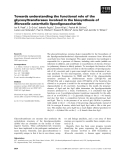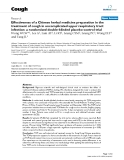


Upper respiratory tract infections
-
Air pollution is a significant global health concern, linked to numerous severe health outcomes, particularly respiratory infections. This study aims to synthesize the impact of air pollution on URTI from 2010 to 2019 to provide a basis for effective public health interventions.
 12p
12p  viyamanaka
viyamanaka
 06-02-2025
06-02-2025
 5
5
 2
2
 Download
Download
-
The glycosyltransferase enzymes (Lgts) responsible for the biosynthesis of the lipooligosaccharide-derived oligosaccharide structures from Moraxella catarrhalishave been investigated. This upper respiratory tract pathogen is responsible for a spectrum of illnesses, including otitis media (middle ear infection) in children, and contributes to exacerbations of chronic obstruct-ive pulmonary disease in elderly patients.
 14p
14p  galaxyss3
galaxyss3
 19-03-2013
19-03-2013
 38
38
 4
4
 Download
Download
-
Tuyển tập các báo cáo nghiên cứu về y học được đăng trên tạp chí y học Critical Care giúp cho các bạn có thêm kiến thức về ngành y học đề tài: Effectiveness of a Chinese herbal medicine preparation in the treatment of cough in uncomplicated upper respiratory tract infection: a randomised double-blinded placebo-control trial...
 9p
9p  coxanh_4
coxanh_4
 26-10-2011
26-10-2011
 70
70
 4
4
 Download
Download
CHỦ ĐỀ BẠN MUỐN TÌM














